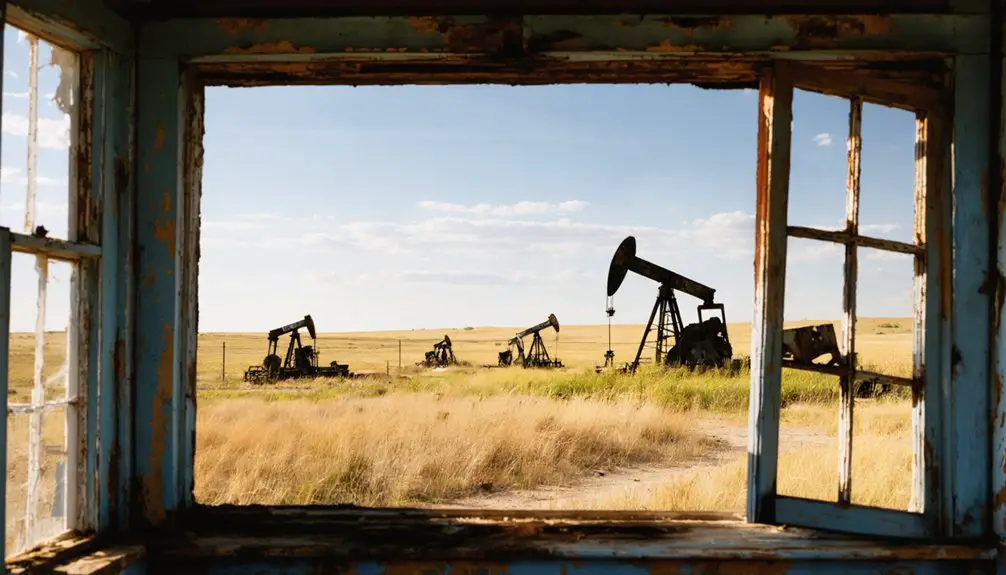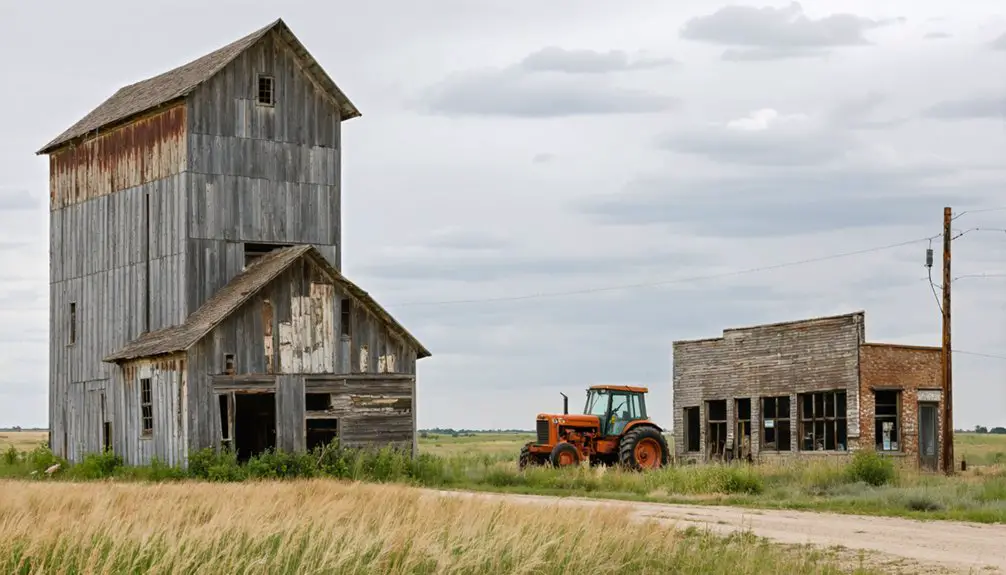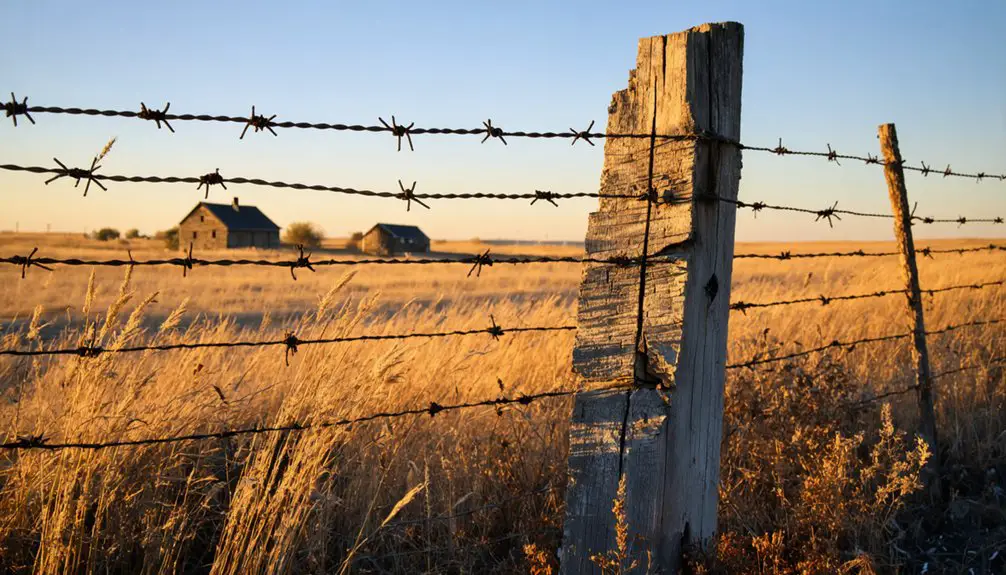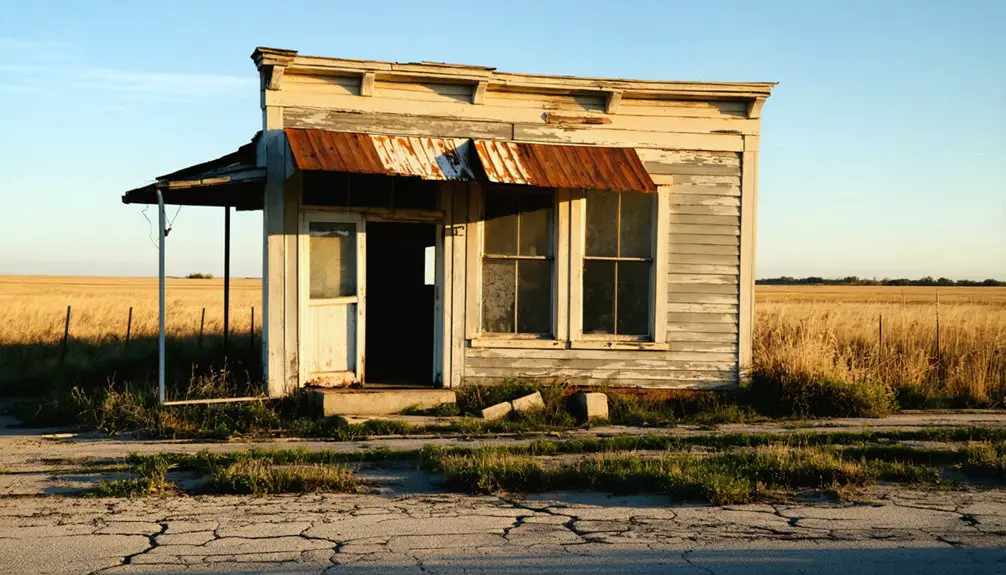You’ll find Hitschmann, Kansas along the old Santa Fe Railroad line, where J.A. Hitschmann’s 1917 land deal created a bustling prairie town. This small community thrived through early settlement challenges and experienced new life during the 1930s oil boom, when the National Cooperative Refinery Association brought workers and housing. Today, weathered buildings and overgrown paths tell the story of a once-vibrant railroad stop that mirrors many similar Kansas towns’ destinies.
Key Takeaways
- Hitschmann, Kansas was established in 1917 along the Santa Fe Railroad line and named after landowner J.A. Hitschmann.
- The town experienced significant growth during the 1930s oil boom, which temporarily revitalized its economy and population.
- The Hitschmann Cash Store served as the town’s commercial center through the Great Depression and oil boom years.
- Population decline began in the 1940s due to agricultural modernization and youth migration to larger cities.
- The town was sold in 1986 and is now a ghost town with abandoned buildings, including a brick high school and worker housing.
The Railroad Town’s Birth Story
When the Santa Fe Railroad revealed plans to build a line from Little River to Galatia in 1917, the small town of Hitschmann sprang to life along the proposed route.
You’ll find that this pattern of town development was common throughout the American West, as railroad expansion opened up new opportunities for settlement and commerce.
The story of Hitschmann’s birth reflects the pioneering spirit of early Kansas settlers.
As the Atchison, Topeka and Santa Fe Railway laid its tracks, local farmers entered negotiations for land use, recognizing the potential that a railroad connection could bring to their community.
The town’s strategic location near the railway line proved essential to its initial growth, transforming what was once empty prairie into a bustling stop along the iron rails.
By 1889, Hitschmann had established itself as a significant point along the railway’s expansion through Kansas.
The town earned its name when J.A. Hitschmann finally agreed to allow the railroad to divide his farmland, though he initially resisted the idea.
A Name’s Legacy: J.A. Hitschmann’s Deal
You’ll find that J.A. Hitschmann’s negotiation with the Santa Fe Railroad in 1917 centered on a unique exchange of land rights for legacy.
When railroad officials needed his farmland for their Little River to Galatia line, Hitschmann initially refused but eventually struck a deal to let the tracks cross his property in exchange for naming the new town after him.
The agreement guaranteed that Hitschmann’s name would become permanently woven into Kansas geography, making his land rights negotiation stand out from typical railroad town naming practices that favored corporate figures.
Railroad Naming Negotiation
In a pivotal 1917 negotiation, the Santa Fe Railroad struck a unique deal with landowner J.A. Hitschmann that would shape Barton County’s landscape. When railroad officials proposed building a line from Little River to Galatia, they faced initial resistance from Hitschmann, whose land stood in their path.
Following common railroad naming conventions of the era, officials offered a compelling compromise: they’d name the new town after Hitschmann in exchange for his cooperation. This strategic approach to railroad negotiations proved successful, as Hitschmann agreed to let the line cross his property. This practice was similar to how the Kansas Pacific Railway had secured land rights in earlier decades.
The deal exemplified how railroads secured right-of-way agreements in early 20th century Kansas, leaving a lasting legacy in local history. While the town later struggled economically, the naming agreement opened doors for future development, including an oil boom in the 1930s.
Land Rights Exchange
The story behind Hitschmann’s land rights exchange reveals a masterful negotiation between railroad officials and a determined Kansas farmer.
You’ll find that when the Santa Fe Railroad sought to divide J.A. Hitschmann’s property in 1917, they encountered a steadfast defender of land ownership rights who wouldn’t easily yield.
Rather than force the issue, railroad officials employed creative negotiation strategies, offering to name the future town after Hitschmann in exchange for the needed access.
This compromise protected his homestead from being split into unusable parcels while securing essential railroad infrastructure.
Though the deal didn’t guarantee immediate prosperity, it exemplified how private landowner rights and public development could find common ground, ultimately shaping the destiny of this small Kansas community.
Life in Early Settlement Days
Life in early Hitschmann centered around the constant struggle to build a viable railroad town from scratch, as you’d find residents working tirelessly to establish basic amenities and services.
You’d see the town’s pioneering families facing harsh economic realities, particularly during the Great Depression when the Hoffman’s cash store served as a lifeline for the small community. Just like in Bell Plane’s orchards, agriculture was the economic foundation that sustained many early settlers.
The shared hardships fostered a tight-knit community spirit, with townspeople supporting each other through the challenges of frontier living and the uncertainties of depending on railroad commerce. The discovery of oil in the 1930s helped revitalize the town’s struggling economy during difficult times.
Pioneering Railroad Town Life
Settlers flocking to Hitschmann in 1917 found themselves part of a typical western railroad town, where daily life revolved around the newly laid Santa Fe line from Little River to Galatia.
You’d have witnessed the pioneering spirit of farmers like J.A. Hitschmann, who negotiated the railroad’s crossing through his land in exchange for naming rights to the settlement.
The railroad culture shaped every aspect of daily life, from the positioning of homes and businesses along the tracks to the steady stream of goods and travelers passing through.
You’d have found yourself among a close-knit community of farmers who gathered at common meeting points near the rail line.
The town’s layout reflected this railway-centered existence, with the unnamed town center serving as a hub for essential services that kept the community connected.
Daily Struggles and Survival
While dreams of prosperity drew pioneers to Hitschmann, harsh realities quickly set in as families faced severe resource scarcity and devastating health challenges.
You’d find settlers struggling to secure enough food and clean water, often relying on local springs or wells that weren’t always safe to drink. Resource scarcity meant you’d live in basic sod houses or dugouts, sharing cramped spaces with extended family while battling the harsh Kansas elements.
Medical care remained out of reach, forcing you to treat illnesses with home remedies. Yet community resilience emerged through shared hardships – families supported each other, trading what little they had.
When work disappeared during the Depression, you’d join the steady stream of residents seeking opportunities elsewhere, demonstrating the pioneering spirit that marked these challenging times.
Community Building Through Hardship
The founding of Hitschmann in 1917 marked a unique chapter in Kansas history, born from a railroad negotiation between the Santa Fe Railroad and farmer J.A. Hitschmann.
Like many frontier settlements, the community’s resilience emerged through shared experiences of hardship and determination.
You’d find families supporting each other through the challenges of early settlement life, from building basic shelters to establishing essential businesses like the Hitschmann Cash Store.
When the Great Depression hit, followed by the promising oil boom of the 1930s, the town adapted by diversifying beyond farming.
Community members worked together to accommodate newcomers, constructing shotgun shacks for oil workers and maintaining multi-purpose buildings that served as churches and schools.
Through economic ups and downs, it was this spirit of mutual support that defined Hitschmann’s character.
The town experienced significant economic growth during the late 1930s oil boom, bringing new life and opportunities to the community.
The Oil Boom Years

During the late 1930s, Hitschmann experienced a remarkable transformation as oil discoveries breathed new life into the struggling town. Oil production brought a surge of workers, and the National Cooperative Refinery Association quickly responded by developing worker housing on rented land.
You’d have seen shotgun shacks springing up to house the labor influx, while local businesses found renewed purpose serving the oil industry’s needs. Like the historic El Dorado oilfield, which produced 29 million barrels annually at its peak, Hitschmann’s oil operations transformed the local economy.
The town’s connection to Kansas’ broader oil boom proved essential, as Hitschmann became part of the extensive Mid-Continent petroleum network. Drilling rigs dotted the landscape, becoming a defining feature of the town’s identity.
You’d have witnessed a bustling community where garages, blacksmith shops, and general stores served the oilfield workers. The boom created a close-knit social environment, though like many oil towns, Hitschmann’s prosperity would eventually fade as production declined in the 1940s.
Notable Businesses and Commerce
Despite its small size, Hitschmann’s commercial heart centered on the Hitschmann Cash Store, originally run by Veat Dolecheck until Frank and Bertha Hoffman took ownership in 1927.
The humble Hitschmann Cash Store, first operated by Veat Dolecheck, became the town’s beating commercial heart under the Hoffmans’ stewardship.
The store faced significant commercial challenges during the Great Depression but found renewed vigor during the late 1930s oil boom.
The town experienced severe hardship during the economic depression, leading to decreased commercial activity and population decline.
You’ll find the town’s local economy was largely sustained by oil industry activities, with the National Cooperative Refinery Association (NCRA) playing an essential role by renting land and building worker housing.
Unlike neighboring ghost towns that boasted hotels, drug stores, and newspapers, Hitschmann maintained a significantly sparse business landscape.
Beyond the Cash Store and oil-related services, few other enterprises took root in the community, though a post office served the surrounding agricultural population.
Population Through the Decades

When Hitschmann emerged in 1917 as a railroad town, its population reflected the modest beginnings typical of many Kansas settlements along the Santa Fe line.
The town’s demographic shifts followed three distinct phases:
- Early growth driven by railroad workers, farmers, and tradesmen through the 1920s
- Brief population surge during the 1930s oil boom, when the National Cooperative Refinery Association brought in workers
- Steady decline from the mid-20th century onward as agricultural mechanization and changing transportation patterns reduced local opportunities
Like other locations documented in Barton County records, Hitschmann’s rise and fall demonstrates the region’s dynamic population changes over time.
You’ll find that Hitschmann’s population trends mirrored many small Kansas towns – from hopeful beginnings to eventual abandonment.
While plans once existed to build 100 houses and establish a thriving community, the town’s destiny took a different path, leading to its sale in 1986 and current ghost town status.
Why the Town Faded Away
The gradual decline of Hitschmann reflects a complex interplay of economic and social forces that ultimately sealed its fate.
You’ll find the town’s economic resilience was first tested in the early 1900s when cheaper coal discoveries elsewhere diminished local mining operations. While a brief oil boom in the 1930s provided temporary relief, the town couldn’t sustain its liveliness once both coal and oil industries waned.
Population decline accelerated as younger residents sought opportunities in larger cities, and agricultural modernization reduced local labor needs.
The closure of the Hitschmann school, coupled with dwindling businesses and services, made the town less attractive for families. Natural disasters and severe weather events further challenged the community’s survival, while the loss of critical railroad connections left the town increasingly isolated from regional commerce and development.
What Remains Today

Today, a scattered collection of decaying structures stands as silent witnesses to Hitschmann’s once-vibrant past. A remnants analysis reveals abandoned business buildings, the brick high school, and worker “shotgun shacks” slowly surrendering to Kansas weather and time.
You’ll find the town largely deserted, though visitor experiences might include encounters with one of the few remaining residents.
For those exploring Hitschmann’s quiet streets, you’ll discover:
- Historic grain elevators and silos reaching skyward, though long dormant
- Overgrown roads with occasional street signs marking forgotten intersections
- Former NCRA oil operation sites, including remnants of worker housing
Nature steadily reclaims the landscape, with vegetation pushing through cracked foundations and weathered buildings telling stories of a bygone era.
Historical Impact on Kansas Plains
As railroads expanded across Kansas in the early 1900s, Hitschmann’s establishment and eventual decline mirrored broader patterns that shaped countless plains communities.
You’ll find its story woven into the fabric of cultural influences that transformed the region, from railroad-driven settlement to oil boom prosperity and eventual ghost town status.
The town’s trajectory reflects the agricultural shifts that reshaped rural life throughout Kansas.
When J.A. Hitschmann allowed the Santa Fe Railroad to cross his farmland, he couldn’t have known how technological advances would later reduce farm labor needs, leading to population decline.
Like many plains settlements, Hitschmann’s fortunes rose and fell with changing industries – first rail transport, then oil production.
Today, it stands as an indication of how transportation shifts and economic dependencies continue to impact small town survival across the plains.
Frequently Asked Questions
Are There Any Remaining Structures Still Standing in Hitschmann Today?
You’ll find some remaining buildings still standing on private property, though they’re deteriorating without historical preservation efforts. Access is restricted, but these structures hint at the community’s past significance.
What Was the Highest Recorded Population of Hitschmann During Its Peak?
You’ll find it challenging to pinpoint the exact highest population since records weren’t well kept, but evidence suggests Hitschmann reached its peak years in the late 1930s with likely 200-300 residents.
Did Any Famous People or Events Originate From Hitschmann?
You won’t find any famous residents or major historical events from this modest railroad stop. The only notable locals were Frank and Bertha Hoffman, who ran the town’s cash store.
Were There Any Schools or Churches Established in Hitschmann?
You won’t find any formal schools or churches in Hitschmann’s education history or religious significance. The town’s small population and brief peak period didn’t support establishing these community institutions.
What Happened to the Original Hitschmann Family After the Town’s Founding?
You won’t find many records about the family legacy or descendants’ stories after Hitschmann’s founding. Beyond J.A. Hitschmann’s initial land contribution, their presence fades from documented town history.
References
- http://kansasghosttowns.blogspot.com/2015/10/a-story-of-hitschmann-kansas-dead-town.html
- https://www.youtube.com/watch?v=Mic2CHaARQE
- https://legendsofkansas.com/kansas-ghost-town-list/
- https://pastmaps.com/explore/us/kansas/barton-county/hitschmann/hiking-exploration
- https://www.treasurenet.com/threads/hitschmann-ks-ghost-town-near-ghost-town.698333/
- https://npgallery.nps.gov/pdfhost/docs/NRHP/Text/08000298.pdf
- https://en.wikipedia.org/wiki/Hitschmann
- https://www.nps.gov/state/ks/index.htm?program=all
- http://kansasghosttowns.blogspot.com/2015/
- https://scholars.fhsu.edu/theses/694/



